
|
xTuple ERP Reference Guide |
To enter a new item into your system, go to . The following screen will appear:

When creating a new item, you are presented with the following options:
Enter a number to uniquely identify the item. Duplicate item numbers will not be accepted.
Select if item is active. Select this option if you intend to use the item within the application. If you don't select this option, the item will be unavailable for use. To activate an inactive item, simply open the Item master and mark the item as active.
An inactive item may still be used in a sales order, work order, or purchase order if the item was de-activated after the order was created.
The Item master features two description lines. The first line is typically used for entering the name used to describe the item. In printed reports or other printouts, the first line will appear on a separate line above the second line. However, the two lines will be concatenated (i.e., joined together) when they are displayed on-screen within the application.
Use the second description line to provide additional information about the item. The second line might include product, packaging, or any other descriptive information. In printed reports or other printouts, the second line will appear on a separate line below the first line. However, the two lines will be concatenated (i.e., joined together) when they are displayed on-screen within the application.
Develop a logical, hierarchical numbering strategy before assigning numbers to your items. Using an hierarchical approach will greatly enhance your ability to display and search for information within the database. An hierarchical numbering scheme might look something like the following:
MB-26-1
MB-26-2
MB-26-3
In this case, similar items have been assigned sequential item numbers. By extension, similar categories of items may be identified by similar numbers.
Select one of the available item types:
Select if the item is an item you purchase. A purchase order is the normal supply order. However, you may enter a work order for this item type.
Select if the item is an item you make. A work order is the normal supply order. However, you may also enter a purchase order for this item type. Job items are considered to be manufactured items. Use the job costing option at the item site level to distinguish job items from regular manufactured items. For more information about the job costing option, please see Job.
A transient subassembly containing component items commonly used together during a manufacturing process. Phantom items require a bill of materials (BOM), but not separate work orders. Since they are not stock items, material requirements planning (MRP) logic blows through phantom items and only plans for their component items. Phantom items should be used to simplify complex BOMs.
Select if the item is an item you sell—but you neither manufacture nor purchase it. Services are an example of reference item. The company sells consulting services, but it doesn't manufacture or purchase them. Reference items may be configured. This means you can add list prices to any reference item characteristics. These characteristic prices are then added to the base price of sales order items when the characteristic is selected at sales order entry.
A kind of pseudo-item used solely to provide a costed value for a costing element. When a user-defined costing element is linked to a costing item, the costing element assumes the costs associated with the costing item. For more information, see Section 6.6, “User-Defined Costing Elements”.
A material resource used in the manufacturing process that is returned upon completion of a work order—for example, a reusable mold, apparatus, fixture, or tool. It may be included on a BOM for an item, usually specifying a fixed quantity. Tooling items can be purchased, manufactured, or sold. A manufactured tool can have a routing, a BOM, and a work order. As with other material items, tools can be tracked as serialized items. The cost of a tooling item is not included in the overall cost of the parent item where it is used.
Select if the item is an external process or service that is performed by someone outside your company. Outside process items are treated by the system in much the same way as purchased items are. For example, outside process items will be handled in the same way as purchased items are when MRP is run.
An item whose BOM groups together other items so that a production plan may be defined for the planning item—and then exploded down to the lower level items during a master production scheduling (MPS) run. Planning items are frequently used to group together product families or product lines of MPS items. MPS items are typically top-level saleable items. By grouping together MPS items under a planning item, the family may be forecasted through with a production plan for the planning item, thereby simplifying the planning process. The system automatically sets the planning system as MPS by default when a planning item is created.
Kit items automatically explode their BOM components on to sales orders for shipping. When kit items appear on sales orders and return authorizations, sub line numbers are generated for kit components because kit children are sub line items of the parent line item. Kit components are displayed as an indented tree on the sales order or return authorization—and they are view-only. Also, kit components will appear on the pick list report. Kit components may be issued to shipping, whereas the parent kit item may not be. The automatic Select for Billing option takes effect for kit items when all kit items are shipped.
The cost of sales (COS) account for kit items is directed to the sales account assignment mappings of the kit's child items—unless your system is configured to have the kit components inherit the same COS account used by the parent kit item. You can read more about configuring your system for COS inheritance for kit items here: Section 12.1.1, “Configure Inventory”.
A logical item from which co-products and by-products are produced. An example use for a breeder item is the screening of raw gravel to produce different sizes of gravel. The breeder item's BOM defines the inputs—in this case raw gravel—and the outputs are defined on its breeder BOM (i.e., small, medium and large gravel). A work order is created for the breeder item, but this item is never stocked or produced; again, it is a logical item. Instead, raw gravel is consumed by the breeder's work order, along with labor, and the resulting quantities of co-products and by-products are recorded.
Co-products are items that you keep and which absorb costs. They are produced during a manufacturing process. (See breeder item type.)
By-products are things that you throw away and incur costs doing so during a manufacturing process. (See breeder item type.)
This is an optional field to be used for entering the maximum cost desired for the item. If used, you will be warned whenever entering purchase orders if the purchased cost exceeds the maximum desired cost value.
Specify a class code to associate with the item.
Specify the item's primary unit of measure (UOM)—or enter a free-form UOM. The inventory UOM is the UOM in which inventory is maintained. All inventory transactions, sales transactions, and general ledger transactions reflect movement in inventory UOMs. The inventory UOM is also the base reference for all UOM conversion ratios.
Once transactions have been posted using an item's inventory UOM, you may no longer change the inventory UOM for the item.
Select if you want the item to be included on pick lists when the item is used. Pick lists are printed lists showing the work order material requirements for a specified work order. You may decide not to include an item on pick lists if the item is insignificant or if it is not stored in a stock room but, for example, in a work center instead.
Select if the item may be maintained in fractional quantities. If not selected, the system will assume the item is maintained in its inventory UOM, which is by definition a whole number. This means you may never use fractional quantities of the item (e.g., in manufacturing or purchasing) unless this option is selected.
If you will ever use the item in fractional quantities, then the Fractional option must be selected. If it is not selected, the system will never let you use fractional quantities of the item.
If the item is a manufactured or reference item, then you will have the option to configure the item for assemble to order (ATO) scenarios. This option will be disabled for all other item types. To learn more about product configuration, see our ATO Configurator Topic.
Select the freight class for the item.
Enter the bar code for the item.
Standard bar code formats supported by the system include the following: Code 3of9, Code 3of9 Extended, Code 128, UPC-A, UPC-E, EAN-8, EAN-13.
Select if the item is an item you sell. If not selected, the associated fields will be disabled.
Specify the product category if the item is sold. All sold items must be assigned a product category.
Specify the list price for the item, based on the selling UOM (i.e., per UOM). List prices may also be created and modified in the item pricing section of the module. Changes made to the list price in either location will be updated system-wide.
Specify the wholesale price for the item. The wholesale price may be used as the unit cost for markup purposes, depending on your pricing configuration. For more information, please see Use Wholesale Price as Unit Cost for Markups.
Specify the selling UOM for the item. The list price should be based on this selection. By default, the inventory UOM will be used here. You will not be able to select a different UOM until you first manually create a selling UOM using the options found under the tab on the Item master.
Select if the item is sold exclusively. If a sold item is marked as exclusive, it may only be sold to specified customers or customer types. To link exclusive items to customers, you would first include the item on a pricing schedule—indicating relevant prices and quantity breaks. You would then assign the pricing schedule to specified customers or customer types, using the pricing schedule assignment functionality found in the item pricing section of the module.
Sold items can be configured as exclusive by default at the level.
If the item is sold with a warranty, specify the number of days the warranty extends for. The warranty period begins on the date the item is sold and ends on the specified number of days afterward. Setting this option to "0" days indicates the item does not come with a warranty.
The sold warranty should not be confused with the purchased warranty, which is defined at the level.
Enter details related to the weight of the item, measured in pounds.
Specify the pre-packaging weight of the product, in pounds.
Specify the weight of the product packaging, in pounds.
Enter additional details related to the item.
This is a scrolling text field with word-wrapping for entering notes related to the item. Any notes entered on this screen are for internal purposes only.
The Extended Description field is for entering descriptive item information, which may be printed on sales and/or purchasing documents. You would add the extended description to printed documents using the report writer. The report writer enables you to customize forms to include data stored in the database. To enter an extended description of an item, select the Extended Description option.
To view system-generated comments associated with an item—or to add new and edit comments of your own—select the Comments option.
The following buttons are unique to this screen:
Select to open the BOM for the specified item. If no BOM exists, you will have the option to create a new routing.
Select to open the routing for the specified item. If no routing exists, you will have the option to create a new routing.
Select to open the Item Availability workbench for the specified item.
Item characteristics are user-defined definitions of an item which may be used to provide additional layers of description to items. For example, item characteristics might be used to specify Season or Primary Vendor. These constitute static descriptions which are not processed by the application, but are useful for informational purposes. For configured items (i.e., job or reference items), characteristics are used to store pricing information for the options available on configured items. That pricing by characteristic is then passed to sales order line items when particular configurations are sold.
Item characteristics can be associated with sales order, purchase order, and work order items.
To enter characteristics associated with an item, select the tab. The following screen will appear:
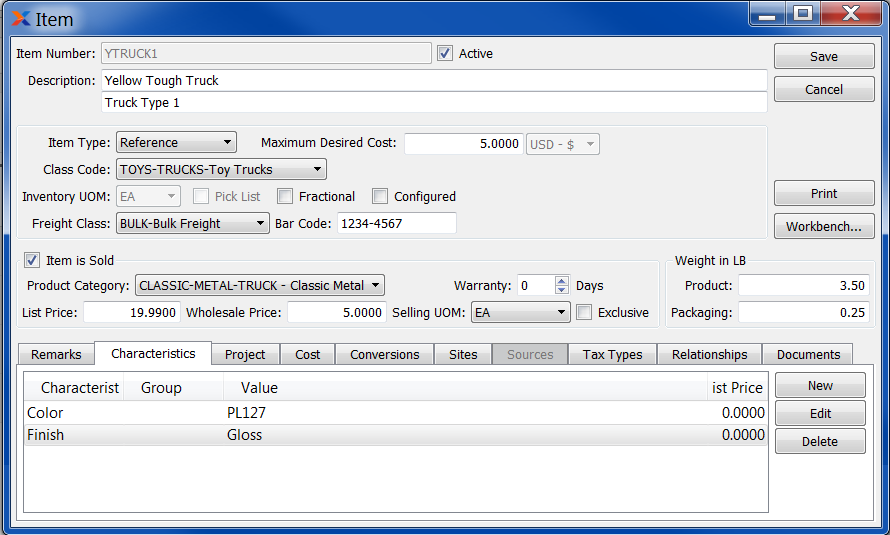
For configured items, an additional pricing field will be available on the Item Characteristic screen. This pricing information will be passed to sales order line items when particular configurations are sold. The price for configured items may vary depending on the characteristics selected at sales order entry time.
To create a new characteristic for your current context, select the button from the characteristics list. The following screen will appear:
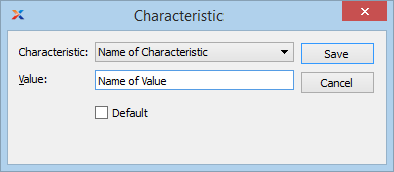
When creating a new characteristic, you are presented with the following options:
Select a characteristic from the list of characteristics available for your current context. To learn more about how characteristics are linked to specific contexts, please see Section 9.2.2.1, “Characteristic”.
Enter a value to associate with the characteristic.
In some contexts, the Default option will appear. Select if the value entered is the default value for the specified characteristic. Default values will always be listed first where characteristics are used.
If you have the Time & Expense package running in your ERP, you'll see the tab in the Item screen. The tab will only be enabled if the item is a reference item, because reference items act as expense items through the time and expense system. If the tab is disabled, then it's likely the item in question is not a reference type item. Select the tab to see the following screen:
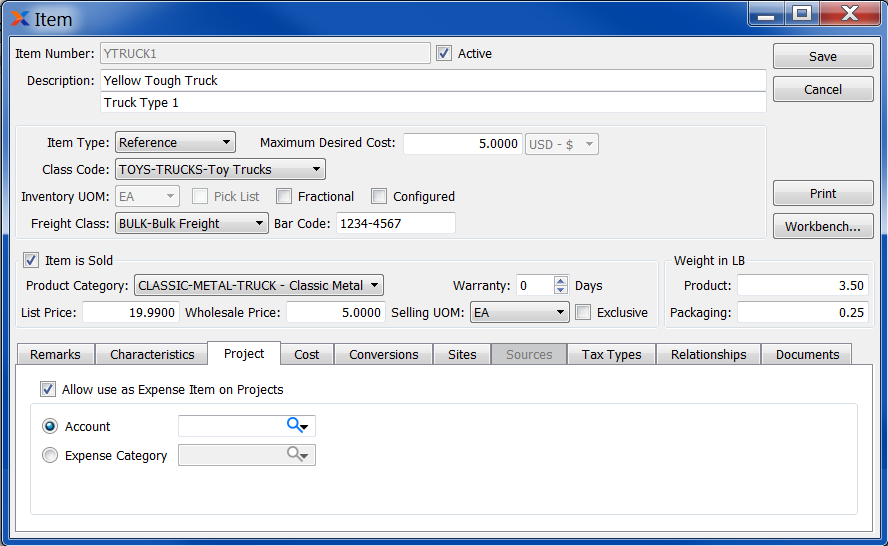
When viewing item project information, you are presented with the following options:
You must select this option—and also define an expense category or account—for the item to be available to users who are entering time & expense sheets.
Define which ledger account number the item will belong to.
Specify the expense category you want to assign the item to.
For visibility into costs and BOMs associated with items—and to perform routine cost and BOM maintenance—select the tab. The following screen will appear:

You are presented with the following options:
Select this option to maintain item cost elements. For more information on maintaining item costs, please see Section 6.1, “ Maintain Item Costs”.
Select this option to maintain the BOM. For more detailed information on maintaining BOMs, please see Section 1.1, “Bills of Materials”.
In addition to the inventory UOM, which is defined on the Item master, you also have the option to convert UOMs for an item. The following alternate UOMs may be defined:
Alternate capacity
Capacity
Material issue
Selling
Unless you define an alternate UOM, an item will always be stored and used in its inventory UOM. For example, you must define a selling UOM if you want to enable an item to be sold in a UOM other than the inventory UOM. To enter UOMs associated with an item, select the tab. The following screen will appear:
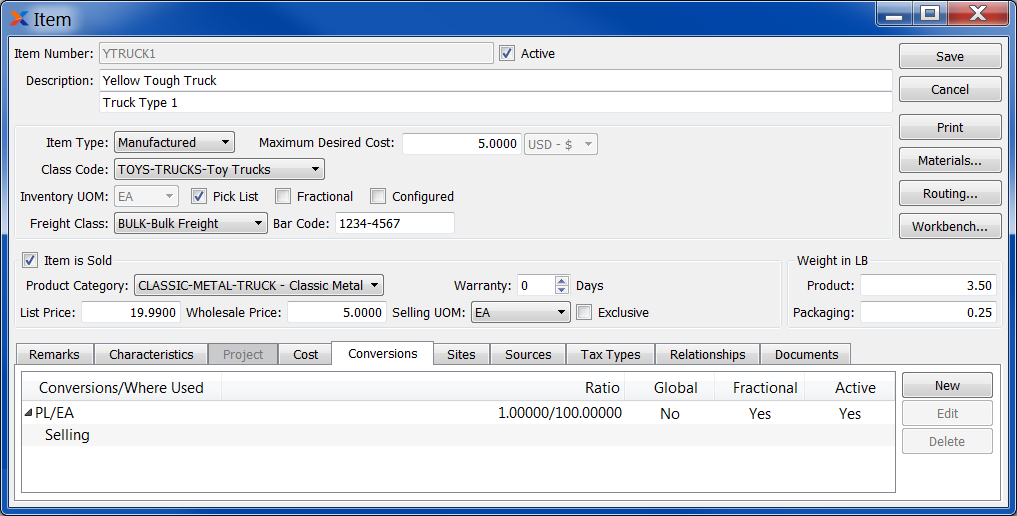
Item Conversions
Display lists the UOM conversions defined for the item (if any) and where these conversions are used. Global conversion ratios are defined in Section 9.2.11.1.1, “Global Conversion Ratio”.
To define an alternate item UOM, select the button. The following screen will appear:
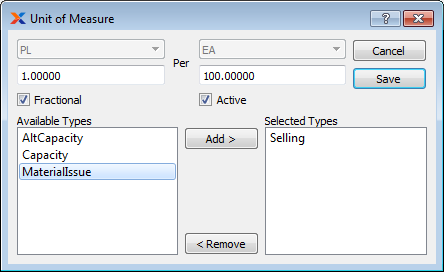
Unit of Measure definition
When defining an alternate item UOM, you are presented with the following options:
By default, the available types list will be empty—until you specify either a source or per UOM. Once a source or per UOM is selected, the available types list will be populated with the available options. An item may have multiple selling UOMs but only one of each of the other types.
By default the inventory UOM will be displayed here. However, you may select an alternate UOM. If an alternate UOM is selected, then the per UOM will be the inventory UOM.
Enter a value for the source UOM to be used in the conversion ratio for the alternate item UOM.
By default the inventory UOM will be displayed here. However, you may select an alternate UOM. If an alternate UOM is selected, then the source UOM will be the inventory UOM.
Enter a value for the per UOM to be used in the conversion ratio for the alternate item UOM.
Specify whether this alternate item UOM may be maintained in fractional quantities. If not selected, transaction quantities using this alternate item UOM may not be maintained in fractional quantities.
Specify whether the conversion is active or not.
Once a source or per UOM has been specified, you may select one of the available UOM types. Once a UOM type has been used, you may not create a conversion ratio for it again—with the exception of the selling UOM, which may be defined multiple times for a single item.
Double-clicking on an available UOM type will move it to the selected types list.
The alternate capacity UOM should be used to provide an alternate UOM for viewing inventory details. For example, a sales manager may be satisfied looking at a group of items normalized to their selling or inventory UOM, but a production manager may need to look at the same items normalized to a production UOM—say, cubic feet (CuFt).
The alternate capacity UOM has no impact on BOMs. It is used solely for capacity planning and sales analysis purposes.
In capacity planning and sales analysis reports, the capacity UOM enables you to make apples-to-apples comparisons of items that use different inventory UOMs. For example, let's say that item A is a carton containing 24 item B's—and that you sell both items. However, item A and item B use different inventory UOMs. Item A is measured by the (CASE [24]), and item B is measured by (EACH). By utilizing the capacity UOM, you have the ability to track total load and total sales for item B—even though the inventory UOM for item A obscures the quantity of item B's contained therein. If, when you query the database, you request data to be displayed in capacity UOMs, then the system will normalize the quantities of item A to (EACH), allowing you to see the total quantity of item Bs.
The capacity UOM has no impact on BOMs. It is used solely for capacity planning and sales analysis purposes.
The material issue UOM defines an alternate UOM for use when creating BOM items. On the BOM Item screen, you have the ability to select an issue UOM. This issue UOM is used whenever the specified component item is issued to a work order. If you define a material issue UOM on the Item master, then that UOM will be available for selection whenever the item is used in a BOM.
If an item is sold, its list price will be based on the selling UOM. While the selling UOM may often mirror the inventory UOM, in some scenarios the two UOMs will be different. For example, cans of soda may be stocked in inventory as individual units (EACH), but sold by the case (CASE24). In this example, inventory transactions will be recorded using the inventory UOM (EACH), but all pricing—including list price and pricing schedules—will reflect the selling UOM (CASE24). An item may also have multiple selling UOMs (for example SIX-PACK, CASE24, PALLET, etc.). You specify the selling UOM you want to use at sales order entry time.
Lists the UOM types you have selected for the specified UOM conversion ratio. You may add multiple different UOM types for each conversion ratio. However, if a UOM type (except the selling UOM) has already been used in another conversion ratio, you may not be able to select it.
Double-clicking on a selected UOM type will remove it from the list, returning it to the available types list.
To view, add, or edit item sites associated with an item, select the tab. The following screen will appear:
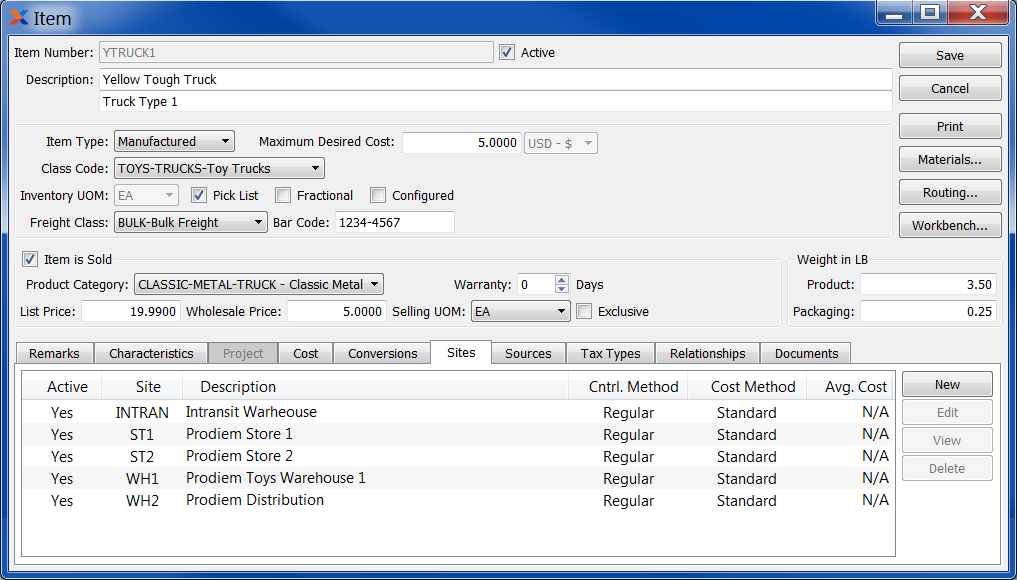
Display lists item sites for the specified item. For more information, see Section 9.1, “Enter Item Site”.
To view the vendor item sources for an item select the tab.
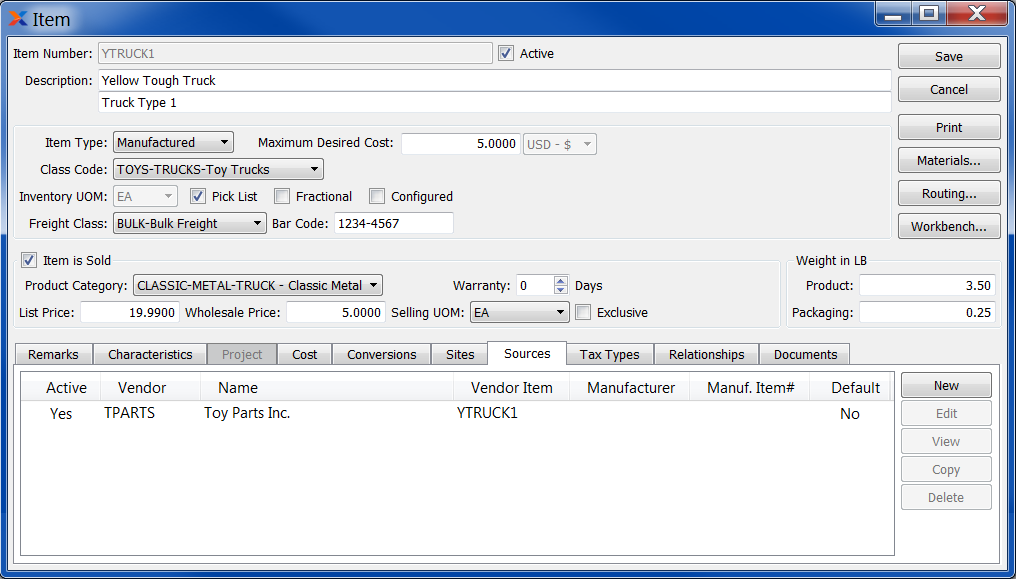
Displays list of item sources and associated vendors. You may also add new item sources for an item on this screen. For additional documentation related to setting up item sources for an item, see Section 9.1, “Enter New Item Source”.
The tax policy for an item is determined by how its tax type settings are configured. To associate tax types with an item, select the tab. The following screen will appear:
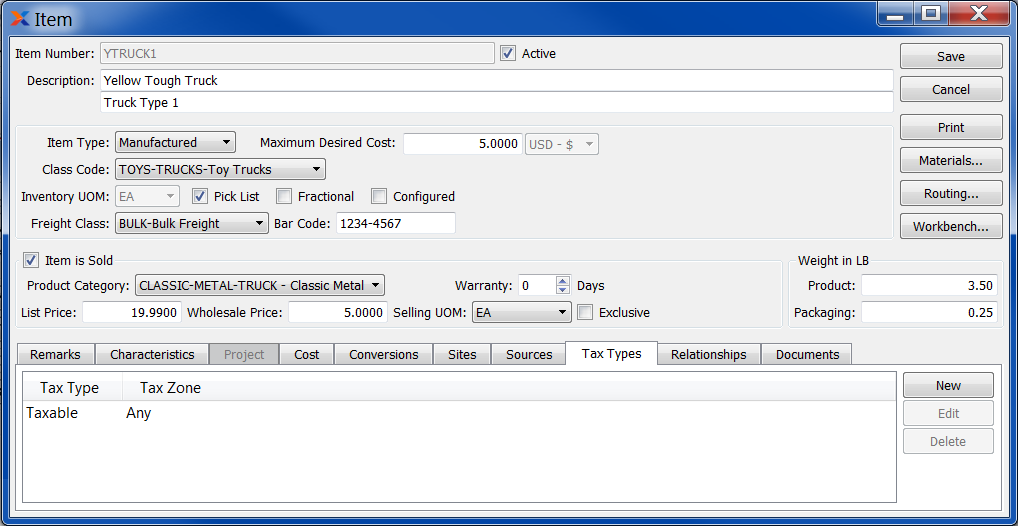
To mark an item as non-taxable, simply do not associate any tax types with the item.
Display lists tax types for the specified item.
To create a new tax type definition, select the button. The following screen will appear:

When creating a new tax type definition, you are presented with the following options:
Specify the tax zone you want to associate with the specified tax type. Creating a relationship between a tax zone and a tax type enables you to determine how tax will be applied when processing transactions using the item. If you select the Any option, this means any defined tax zone is a possible match.
Consider creating separate tax types for any groups or classes of items which are taxed at different rates.
Specify the tax type you want to associate with the specified tax zone. Tax types provide a system for classifying goods and services into taxable categories. Creating a relationship between a tax zone and a tax type enables you to determine how tax will be applied when processing transactions using the item. If you select the Any option, this means any defined tax type is a possible match.
Item relationships are assigned to items as a means for cross-referencing internal and external item information. For example, a customer may refer to an item by a different item number than you do. To avoid confusion—and to simplify item lookups—you can create an item alias linking the customer's external part number to your own internal item number. The item alias acts as an alternate identifier. In this way, items may be located using either internal or external item information. To associate an item alias with an item, select the tab. The following screen will appear:

When associating alias relationships with an item, you are presented with the following options:
Display lists item alias numbers and related comments.
Multiple item aliases can be assigned to a single item, allowing you to cross-reference an item using many different item numbers.
To create an item alias, select the button. The following screen will appear:
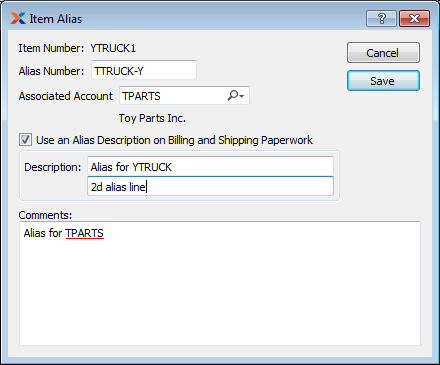
When creating a new item alias, you are presented with the following options:
Item number entered into previous screen will be displayed.
This is the alias number for the item.
You have the option to link a CRM account to the item alias. If linked, the alias will only be used on quotes and sales orders related to the specified customer. If no customer is specified, the alias will be displayed for all customers you sell the item to.
Select to include an item alias description on billing and shipping paperwork.
Enter a description of the item alias for inclusion on billing and shipping paperwork.
This is a scrolling text field with word-wrapping for entering comments related to the item alias. This field may be useful for explaining why an item alias was created (e.g., customer XYZ, Inc. refers to this item alias whenever they place an order.).
To associate item substitutes with an item, select the Substitutes radio button. The following options will appear:
Display lists item substitutes, including rank and item description.
Multiple item substitutes can be assigned to a single item, allowing you to cross-reference an item using many different item numbers.
There is a difference between item substitutes and substitutions defined in a BOM. The difference is that BOM-defined substitutions may be implemented on the fly during work order processing—item substitutes cannot be.
To create a new item substitute, select the button. The following screen will appear:
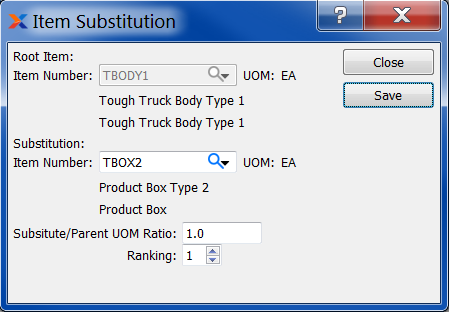
When creating a new item substitute, you are presented with the following options:
Item number entered into previous screen will be displayed.
Inventory unit of measure.
Enter the item number of the substitute item.
Inventory unit of measure.
Specifies the ratio between the root item's inventory UOM and the substitute item's inventory UOM.
Select a number using the arrows, or manually enter a value up to a maximum of 9 to specify the rank of the item substitute. The ranking determines the order in which the item substitute will appear in the substitute list accessed from the Maintain Work Order Materials screen. The item substitute having the highest rank will appear at the top of list, and so on in descending order. You may assign the same ranking to multiple items, if this is appropriate.
To associate transformation options for an item, select the Transformations radio button. The following options will appear:
Display lists items which may be chosen as target items during transformation transactions.
You may only transform an item if the source item is located in the same site as the target item.
To associate documents with an item, select the tab. The following screen will appear:
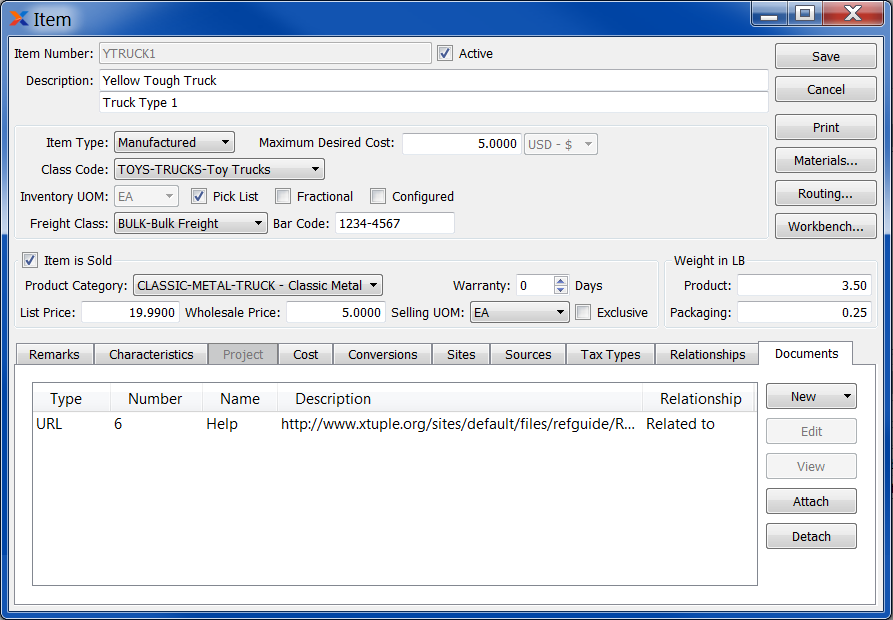
Item Documents
When associating documents, you are presented with the following options:
Select to create a new document and associate it with the current record. You may create the following document types:
Select to create a new image association.
Select to create a new fixed asset association.
Select to create a new maintenance order association.
Select to create a new incident and associate it.
Select to create a new project and associate it.
Select to create a new opportunity and associate it.
Select to create a new task and associate it.
Enables you to edit associated documents. The Edit screen is the same as that for creating a new document—except that when editing, the fields will contain document information. Double-clicking on a document will also bring you to the editing screen.
Highlight a document and then select this button to reach a read-only view of the Edit screen.
Select to associate already-existing documents. The following document types may be attached: contact, account, customer, employee, file, image, incident, item, opportunity, project, purchase order, sales order, vendor, web site, work order.
Highlight a document and then select this button to remove the association.
To associate already-existing documents, select the button. The following screen will appear:
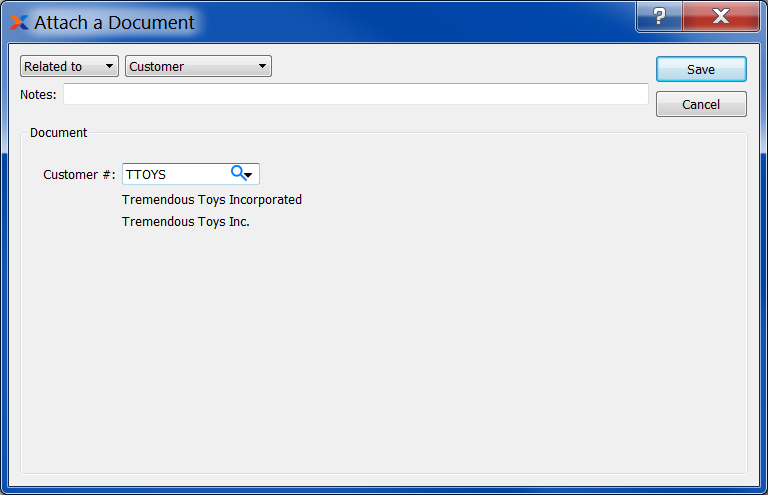
When associating already-existing documents, you are presented with the following options:
Indicate how the document is related to the current record. The following relationship options are available: related to, parent of, child of, duplicate of.
Specify the kind of document you want to associate. The following document types may be attached: contact, account, customer, employee, file, image, incident, item, opportunity, project, purchase order, sales order, vendor, web site, work order. When associating files, you will also be given the option to save the file to the database.
There is no file size restriction when saving files to the database. However, excessively large files could cause storage and performance issues.
Leave any notes on the document file as needed.
Use the lookup tool to identify the specific document you want to attach. The data entry options will vary depending on the document type you select.